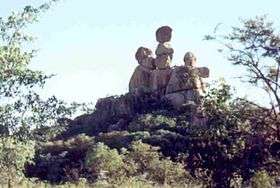Balancing Rocks
| Balancing Rocks | |
|---|---|
 Balancing formation seen in Matopos National Park, known as the Mother and Child inselberg | |
| Highest point | |
| Elevation | 1,473 m (4,833 ft) [1] |
| Coordinates | Coordinates: 17°53′13.3″S 31°7′51.2″E / 17.887028°S 31.130889°E |
| Geography | |
| Location | Epworth and Matopos National Park, Zimbabwe |
| Parent range | Throughout Zimbabwe |
The Balancing Rocks are geomorphological features of igneous rocks found in many parts of Zimbabwe, and are particularly noteworthy in Matopos National Park and near the township of Epworth to the southeast of Harare. The formations are of natural occurrence in a perfectly balanced state without other support. Their popularity grew when the Reserve Bank of Zimbabwe featured the formations on the last series of Zimbabwean banknotes.[2][3][4][5]
The Balancing Rocks have been used as a metaphorical theme to explain the importance of development coupled with preserving the fragile environment of Zimbabwe as similar to that of the Balancing Rocks found in Epworth, Matopos and in other areas.[6]
Geography
The Balancing Rock formations are seen throughout Zimbabwe. They were created when ancient granite intrusions were exposed to weathering, as softer rocks around them eroded.[4] Also known as Balancing Rock kopjes, they are seen in the form of huge angular blocks of granite "piled on top of and beside one another, forming pillars and stacks, like a child's building blocks."[3] Two prominent formations are at Matapos and at Epworth.[3]
Matopos
The natural shelters formed by the rock formations in the Matopos Hills, which are part of the Matopos National Park in Central Zimbabwe, have been in existence since the Stone Age. These have contributed to the development of rock art in Southern Africa, development of religious traditions of the people who inhabited the area and to the evolution of the Mwari religion; all of which have been, as one complex, recognized as of heritage importance with the area receiving UNESCO recognition as a UNESCO World Heritage Site, under well defined categories of (iii), (v) and (vi). The land forms here are examples of the granite formations, which dominate Zimbabwe's land form as "crenellated ridges, dwalas or hump-backed domes, and what look like randomly heaped boulders which have evolved in various forms over millions of years of weathering." The most impressive Balancing Rock formation in these granite ranges is of the Motabo Hills, which is the inselberg of "Mother and Child Rock formation".[4] The Balancing Rocks found here are described as the best granite outcrops in "Dali-esque compositions of lichen streaked balancing rocks."[7]
Epworth

A famous balancing rocks formation is located 13 kilometres (8.1 mi) southeast of Harare, off the Chiremba Road. These rocks achieved fame when they were featured prominently in the design of Zimbabwe's bank notes.[2]
References
- ↑ http://www.mountain-forecast.com/peaks/Balancing-Rocks
- 1 2 Paul Murray (2010). Zimbabwe. Bradt Travel Guides. pp. 166–. ISBN 978-1-84162-295-8. Retrieved 11 February 2011.
- 1 2 3 A. J. Chennells; Flora Veit-Wild (1999). Emerging perspectives on Dambudzo Marechera. Africa World Press. pp. 153–. ISBN 978-0-86543-645-9. Retrieved 11 February 2011.
- 1 2 3 "Matobo Hills:Brief Description". Unesco.org. Retrieved 11 February 2011.
- ↑ "Balancing Rocks". Fortune City. Archived from the original on 17 August 2009. Retrieved 11 February 2011.
- ↑ Carlos Lopes (February 1996). Balancing rocks: environment and development in Zimbabwe. Nordic Africa Institute. ISBN 978-91-7106-394-6. Retrieved 11 February 2011.
- ↑ Barbara McCrea; Tony Pinchuck (20 July 2000). The rough guide to Zimbabwe. Rough Guides. p. 146. ISBN 978-1-85828-532-0. Retrieved 11 February 2011.